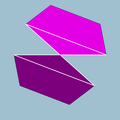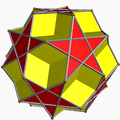| Great dodecahemicosahedron | |
|---|---|
 | |
| Type | Uniform star polyhedron |
| Elements | F = 22, E = 60 V = 30 (χ = −8) |
| Faces by sides | 12{5}+10{6} |
| Coxeter diagram | |
| Wythoff symbol | 5/4 5 | 3 (double covering) |
| Symmetry group | Ih, [5,3], *532 |
| Index references | U 65, C 81, W 102 |
| Dual polyhedron | Great dodecahemicosacron |
| Vertex figure |  5.6.5/4.6 |
| Bowers acronym | Gidhei |

In geometry, the great dodecahemicosahedron (or great dodecahemiicosahedron) is a nonconvex uniform polyhedron, indexed as U65. It has 22 faces (12 pentagons and 10 hexagons), 60 edges, and 30 vertices. [1] Its vertex figure is a crossed quadrilateral.
Contents
It is a hemipolyhedron with ten hexagonal faces passing through the model center.




